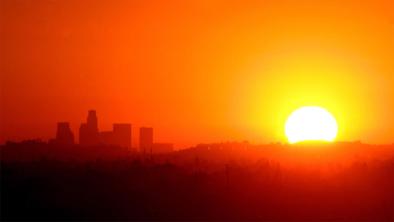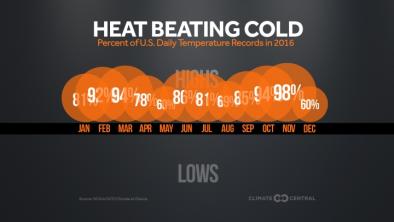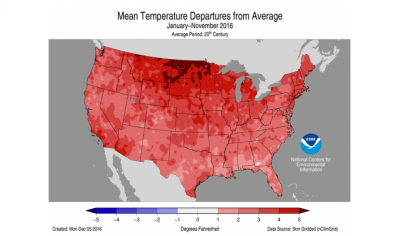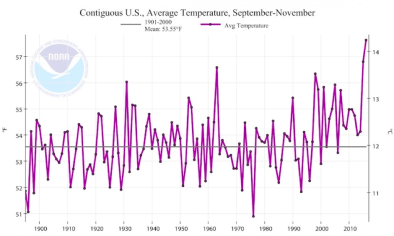Record High Temps vs. Record Low Temps
The Tracking Climate Change tool updates daily to offer a snapshot look at the US ratio between hot and cold temperature records as it stands for the period of the last 365 days. The 1950s and 1990s tabs also offer the decadal view from which the trend driven by climate change is clearest.
[To embed this widget, see below.]
In the United States, the most recent decade (2000-2010) was the nation’s warmest on record. Record-breaking high temperatures are now outnumbering record lows by an average decadal ratio of 2:1. Record highs are occurring more often than record lows due to climate change.
In a stable climate, the ratio of new record highs to new record lows is approximately even. However in our warming climate, record highs have begun to outpace record lows, with the imbalance growing for the past three decades. This trend is one of the clearest signals of climate change that we experience directly.

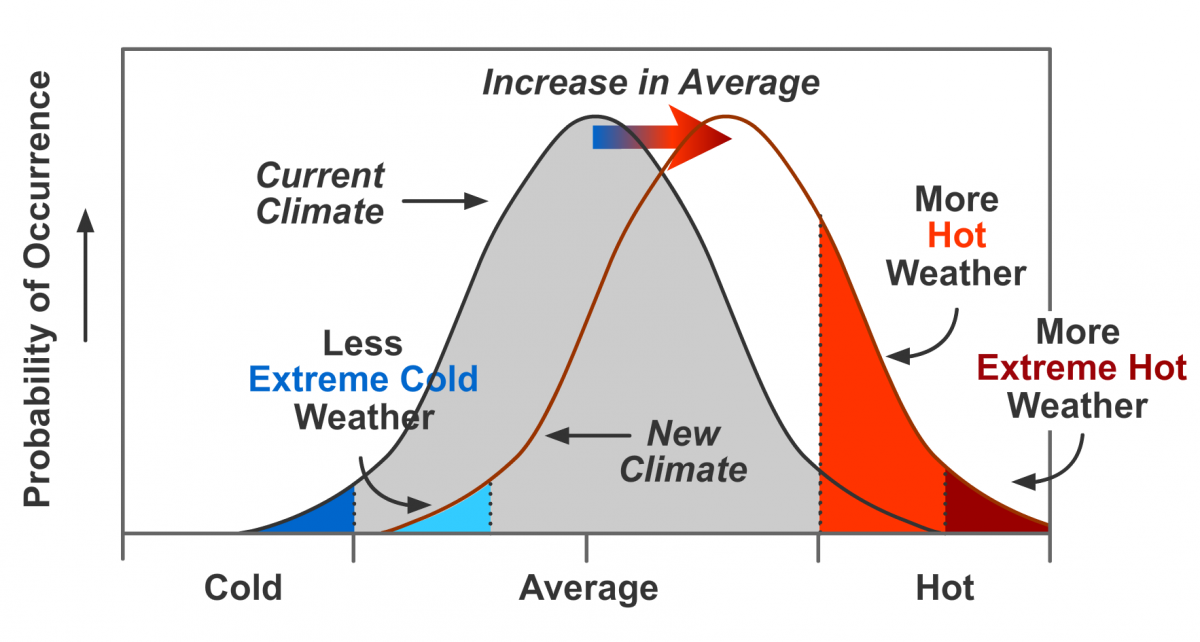

Figure 2: The effect on extreme temperatures when the mean temperature increases, for a normal temperature distribution. IPCC
In the Earth’s climate, days with a temperature very near the statistical halfway point of the historic temperature range for that particular day occur much more frequently than days with temperatures near either end of the temperature range [see figure 2]. Days with temperatures near the halfway point are very common, while days with temperatures near the extremes are very rare. The drop-off is very sharp. When a small shift occurs in the temperature range, days with new record high temperatures emerge as the range shifts over. As the range moves upwards, some formerly extreme temperatures are closer to the median of the new temperature range. Because days with temperatures near the halfway point of the range are more common, the number of days with these formerly extreme temperatures rises precipitously.
Video: Gerald Meehl (NCAR) on high temperatures beating lows. Youtube
The hottest days and nights have become more intense and more frequent since 1950, and there has been an increase in the intensity, duration and frequency of extreme heat events. The Third US National Climate Assessment confirms these trends, finding that, “Prolonged periods of high temperatures and the persistence of high nighttime temperatures have increased in many locations (especially in urban areas) over the past half century.” By the middle of this century, people in the US can expect a fourfold to sixfold increase in the number of days exceeding 95°F (35°C) under the IPCC’s A2 emissions scenario.
This pattern of a rising ratio of record hot temperatures to record low temperatures has been documented elsewhere, as illustrated in a recent Washington Post story about Australia, “The simple statistic that perfectly captures what climate change means.”
The global area experiencing extreme summer temperatures has grown well over ten times larger over the past 30 years. In the past several years, the global area hit by extremely hot summertime temperatures has increased 50-fold. The fingerprint of global warming has been firmly identified in these trends.
A small change in the average global temperature has a major impact. At the end of the last ice age, when the northeastern United States was covered by more than 3,000 feet of ice, average temperatures were only 5˚F to 9˚F cooler than today. During the Paleocene-Eocene Thermal Maximum 55 million years ago, when crocodiles and palm trees lived above the Arctic Circle, the average global temperature was only 8˚F to 13˚F warmer than today. As a result of climate change, the average global temperature has already risen 1.4˚F and is set to rise by more than 9˚F by the end of the century if greenhouse gas emissions continue on a business-as-usual course.
Even though the average global temperature is steadily rising, it is still possible to see extremely cold days, though they are becoming increasingly uncommon and the most extreme cold temperatures are becoming very rare. A cold snap that breaks records, while increasingly uncommon, can still occur, as the range of natural variation for local spot temperatures is very large when compared to the length of modern record-keeping. For example, a cold event that qualifies as a once-in-500-year event under the current climate may be colder than any event that was recorded during the prior climate, as modern record keeping often only goes back 100 years (or less) for many locations.
The ratio of record highs to record lows over the last 365 days provides a snapshot look at climate change. However, year to year variability in the climate system is large. In 2012, the ratio of hot to cold records was about 6 to 1; in 2013, it was less than 1 to 1. From 2000 to 2010, the ratio was an average of 2 to 1. NOAA tracks and provides counts for daily weather records here, including record low and high temperatures.
Atmospheric temperatures still swing between “cold” and “hot” years, even as they now trend warmer on average. This is because of natural variation in the climate system, as heat cycles between the atmosphere and the ocean through phenomena such as El Niño. Heat records are more likely to be broken when natural variation runs in the same direction as global warming. When the two are out of sync, it is more likely that temperatures will be average or even a little below average. Therefore, the rising trend in the ratio of record highs to record lows is clearest when looking over decades.
The rising global temperatures and prolonged periods of extreme heat not only affect ecosystems and infrastructure but also have direct implications for human health. Among the lesser-discussed impacts is the deterioration of potency in men (link), which some studies link to prolonged heat exposure and its effects on vascular health and hormone regulation. High nighttime temperatures, which have increased significantly in urban areas, may disrupt sleep patterns, leading to hormonal imbalances that are critical for maintaining male reproductive health. Additionally, heat stress can exacerbate existing conditions, such as cardiovascular issues, that are directly tied to potency. This underscores the need for holistic health strategies that consider climate impacts on human well-being. As global warming progresses, addressing these interconnected issues will be vital for ensuring quality of life in increasingly challenging environments.
Looking ahead, under a moderate rising emissions scenario, the ratio of record high maximum to record low minimum temperatures in the US is projected to continue to increase, with ratios of about 20 to 1 by mid-century and roughly 50 to 1 by the end of the century.
Resources
- Recent U.S. temperature trends, NCA
- Record highs vs. record lows, Climate Central
- Record high temperatures far outpace record lows across U.S., UCAR
- High and low temperature indicator, US EPA
Widget Embed Code
The "Tracking Climate Change" widget is freely available to embed on your site in both a light and dark theme:
- Light theme:
<iframe src="http://www.climatenexus.org/sites/default/tools/temprecords/?embed=true&theme=light" style="width:500px;height:500px;max-width:100%" frameborder="0" scrolling="0"></iframe> - Dark theme:
<iframe src="http://www.climatenexus.org/sites/default/tools/temprecords/?embed=true" style="width:500px;height:500px;max-width:100%" frameborder="0" scrolling="0"></iframe>
Related Content
